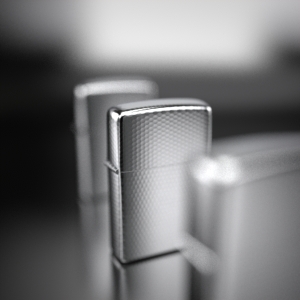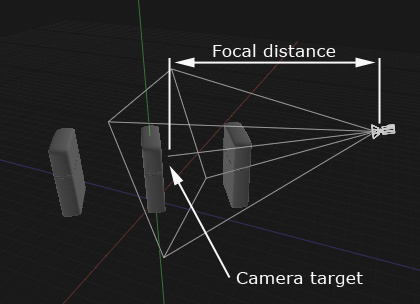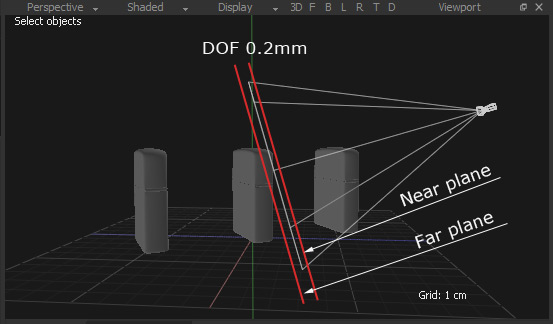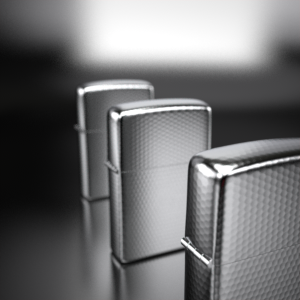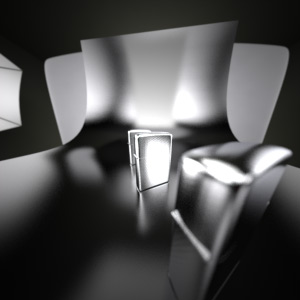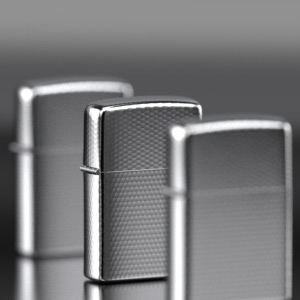The Maxwell Render camera is designed to work like a real camera so it is important to understand some photographic concepts. The most important concept to understand is the Depth of Field (the depth of the area in the render that will be in focus) and the settings that affect it. In a real camera, the depth of field is determined by the focal length and aperture of the lens, the size of the film or digital sensor and the distance of the camera to the object.
Understanding Depth of Field (DOF)
The are several camera parameters which influence the DOF but the main parameters which control it are F-stop and Focal length. Besides the parameters themselves, the most important thing to consider in order to get predictable results is the scale of the objects in your scene. They have to modelled to the real world scale you intend them to be. For more info see Scene scale.
The render above illustrates the DOF effect - only the Zippo in the middle is in focus, while objects extending away from this point of focus get increasingly blurrier. This image is said to have a "narrow" DOF.
The area that will be in perfect focus is where the camera target is located. From the image above you can see the camera target is located close to the Zippo in the middle. The focal distance is the distance between the camera and the camera target.
"Narrow" vs "Wide" DOF
The reason why it is called narrow or wide depth of field is because the area that is in focus extends from the focus point, towards and away from the camera. The depth of this area does not have an absolute start and ending point - the image won't suddenly go out of focus, it is a gradual effect. While the exact point where the camera target falls will be in perfect focus, human eyes cannot tell the difference between very small changes in sharpness, so the depth of the area in focus is based on what is considered to be "acceptable sharpness". How this standard of acceptable sharpness is defined is beyond the scope of this page, what is important to understand is that a narrow DOF will have only a very thin area of the image which appears in focus, while a wide DOF will have most of the image in focus.
In Maxwell Studio, and some of the plugins, you can see a read-out of the DOF when looking through the camera in a viewport:
In the middle you can see the camera focus indicator - it will turn red if the camera target is in front of the object the camera sees, and will turn blue if the camera target is behind the object.
FD: Focal Distance - the distance between the camera and the camera target
Near: the near plane, or the "beginning" of the DOF area
Far: the far plane, or the "end" of the DOF area
DoF: the depth of the area that will be in acceptable focus, in this case only 0.2mm
A side view to demonstrate the FD, Near, Far, DoF indicators
Use Maxwell Fire to preview the DOF in your scene, while changing the Target Distance, F-stop, Focal Length in the Camera parameters
Using DOF to your advantage
Many photographers use the selective focus that a narrow DOF gives to draw the attention of the viewer to a certain part or subject in a photo. For example a narrow depth of field is used for portrait photography to keep the subjects face in focus while blurring out the background to keep it from distracting attention from the subject. It can also be used artistically in architectural photos, if you wish to draw attention to a certain detail of a building.
F-Stop
On a real camera, the F-stop changes the aperture of the lens. A smaller F-stop number (ex. f2.8) means the aperture is more open, a higher F-stop number (ex. f16) means the aperture is more closed:
The effect of changing the F-stop (size of the lens aperture) is two-fold - it changes the exposure (it lets more or less light in to reach the digital sensor or film), and it increases or decreases the DOF. A higher F-stop number creates a larger DOF (more of the image in focus) and vice versa. So as the aperture decreases in diameter with a higher F-stop number, the DOF will increase and the exposure will change, making the image darker. To prevent also the exposure to increase/decrease while changing the F-stop you can use the Auto exposure feature in the Camera settings. When it is checked and you change the F-stop, the shutter speed will also change automatically to compensate for the change in exposure.
The image below shows how the DOF has increased when changing the F-stop from 2.8 to 5.6, while having Auto exposure checked:
On a real lens, changing the F-stop is not a smooth change, but is done in incremental steps because of the mechanics of the aperture blades opening and closing. The common F-stop scale is:
1.0 | 1.4 | 2 | 2.8 | 4 | 5.6 | 8 | 11 | 16 | 22 |
This is called a "full stop" F-stop scale, meaning each increase in the F-stop halves the amount of light reaching the film. Most lenses also have intermediate F-stops, such as 1.2, 1.8, 3.2, 7.1 etc. The Maxwell Camera allows you to change the F-stop to any value you like, for example 3.21 which wouldn't exist in a real lens. It also allows you to set very high F-stop numbers such as 100. It is generally recommended though to use a real lenses range of aperture to have more predictable real life responses to DOF, exposure, and light intensity.
Bokeh
When parts of a photo are very much out of focus, the blurred highlights in the photo tend to take on the shape of the lens aperture. For example if the aperture is made of five opening/closing blades creating a hexagonal shape, the out of focus highlights will have this shape. The Maxwell camera lets you choose whether you want these blurred highlights to have a smooth round shape or a polygonal shape. These settings are found under "Diaphragm" in the Camera parameters
Render with objects in focus
Objects out of focus - Diaphragm set to Circular
Objects out of focus - Diaphragm set to Polygonal, Blades: 5
Focal Length
The focal length of a lens determines the field of view (FOV), or how much you see of your scene, and also the DOF. A small focal length lens (15-24mm) is said to be a wide-angle lens because it captures a lot of the scene (it has a wide FOV), and its DOF is wide too: almost all the objects in the scene will be in focus. A large focal length lens (80-200mm) is said to be a telephoto lens. It acts like a binocular, “zooming” in to a particular area of your scene. It has a small FOV and the DOF will be very narrow too: only a small portion of your scene will be in focus.
The Focal Length of a lens refers to the distance between the lens and its focal point. The focal point is where the light will be focused, usually where the film / digital sensor is.
Comparing two extremes, a very wide angle lens (15mm) and a "telephoto" lens (500mm):
F-stop 5.6, 15mm focal length (extreme wide angle lens), notice the perspective distortion.
F-stop 5.6, 500mm focal length (telephoto lens), perspective is flattened.
In the above examples, the camera with the wide angle lens setting was moved very close to the first Zippo and you can see that it still captures all the Zippos because of the extremely wide FOV. Notice also the perspective distortion that happens with such a wide angle lens - the objects seem more "stretched" and distorted, as when looking through a peephole. Also the distance between each Zippo becomes exaggerated. In contrast, the telephoto lens squashes, or flattens the perpective, it becomes difficult to tell exactly how far apart each Zippo is.
The camera also had to be moved far back to capture all the Zippos. Notice also that with the wide angle lens it is only the Zippo very close to the camera which is out of focus. Any objects not close to the lens will be in perfect focus, no matter the F-stop setting. With the telephoto lens, the DOF is still narrow, even narrower than the render with the same F-stop but with a 50mm lens.
